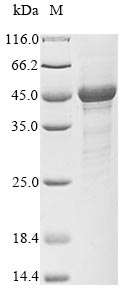This Recombinant Human SKP1 protein is a valuable tool for researchers in the field of cell biology. S-phase kinase-associated protein 1 (SKP1) is a core component of the SCF (SKP1-CUL1-F-box protein) E3 ubiquitin ligase complex, playing a crucial role in cell cycle progression, signal transduction, and ubiquitin-mediated proteolysis.
Our Recombinant Human SKP1 protein is expressed in E.coli, yielding the full length of mature protein (2-163aa) while maintaining its native structure and function. Featuring a C-terminal GST-tag, this protein enables efficient purification and detection, providing consistent and reliable results for your research. The purity of our Recombinant Human SKP1 protein is greater than 90%, as determined by SDS-PAGE, ensuring a high-quality product for your experiments. Available in both liquid and lyophilized powder formats, this protein is designed to meet the diverse requirements of your research.




